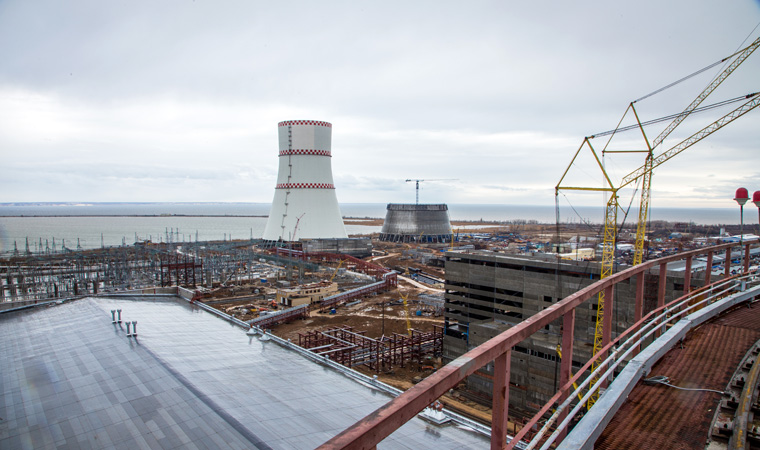
Ready for start up
back to contentsAn example could be the record time of laying cables. Earlier, specialists said that the record of laying 300 kilometers of cable per month made at series VVER power units would never be reached. But last year Beloyarsk plant showed the rate of 500 kilometers of cables per month. Also, record rates were reached at installing heating engineering equipment, Rosenergoatom says. Now, this power unit is at the first stage of the first criticality program, i.e. loading of fuel assemblies in the reactor core. To enter the second stage, 558 fuel assemblies should be loaded. “A total of 1,233 components are planned to put in the reactor core,” says Gennady Sakharov, Director for Capital Investments at ROSATOM and head of the sectoral capital projects center. By date, 236 of these have been loaded. The work is on schedule, he states. The second stage of the first criticality program will include the in-pile experiments. The power unit will be connected to the grid and start generating electricity before the end of this year. Now, more than 5,000 staff works on the site.
Bonuses will follow
The third power unit of Rostov NPP is to start this year. It is built to a well-mastered technology of series build of V-320 reactors [VVERs]. “It’s clear down to the smallest nut what equipment is required, Sakharov says. “All stages of commissioning are well-mastered. The experienced operating and repair personnel work on the site. They came from the two first reactors.”
Now, the reactor is being assembled at Rostov-3. All reactor internals, which weigh 150 tons – the barrel, baffle and protective tube system – should be put in during 20 days. Then, 163 dummy fuel assemblies will loaded and the hot runs will start. Rostov-3’s first criticality is set for October and will be followed by connection to the grid in December.
“The timeframe is realistic, Sakharov says. “The team of builders and installation workers expects well-deserved bonuses.” Now, the Izhorskiye Zavody manufactures the reactor equipment, as well as support and thrust rings for Rostov-4. The Rostov NPP construction site engages about 6,000 people today.
At the site of Novovoronezh Phase II the first power unit is built to AES-2006 technology, which uses a VVER-1200 reactor. This produces a special effect on the construction progress. In practice, implementation of new engineering solutions sometimes leads to revealing design deficiencies and to work completion delays. However, ROSATOM’s specialists hope to start up the reactor on the due date in spite of some issues. “Both the customer and principal contractor have the mood and wish to do the outmost to meet the target,” Gennady Sakharov assures. The site of Novovoronezh Phase II currently engages 7,800 people.
Four casings of reactor coolant pumps have been installed in the first reactor building at Leningrad Phase I. In parallel, installation of the support ring is under way. The next in the sequence is installation of the reactor pressure vessel. The related engineering solution document has already been submitted to Rosenergoatom (the operator of Russian NPPs) for approval. “If it is approved, the reactor pressure vessel will be installed using so-called open-way approach [without use of the polar crane and other machinery], Leonid Kostyuchenko, Leningrad II project manager at MSU-90, says. “We will be the pioneering organization who uses this approach to install essential equipment of the reactor.”
Then four steam generators will be installed. Welding of the main circulation pipeline is planned for September. “This is the milestone which will bring us to the first stage of the unsealed reactor tests,” Leonid Kostyuchenko continues. Specialists of the company’s affiliate, UAT, have done a great work volume on building the foundations, floors and erecting walls at Leningrad Phase II. The company currently directs its main resources to the turbine island of the second power unit. Construction workers are building the turbine set foundation. “The work volume increases day-to-day. The falsework, reinforcement and inserts are installed,” Andrey Bondarenko, chief engineer of Section No. 7, says. On the whole, the construction and installation is 67% completed at Leningrad Phase II. Now, the construction site employs over 4,000 people.
Heading to zero
Belarus NPP is built to a Russian technology in a village located in Grodno Region. It will consist of two power unit totaling up to 2,400 MW power. Last November the work was started to concrete foundations of Unit 1 facilities. As per the plans, Belarus-1 should be commissioned in 2018 with Belarus-2 to follow in 2020. Belarus NPP was granted a license to build the first power unit late April, but its construction is already ahead of schedule.
“Its foundation is nearly complete, says Sergey Gorin, deputy head of the reactor department at the Belarus NPP Construction Directorate. “Unit 1 is straightforwardly heading to the “zero” [ground level]: concreting goes on at below-zero levels, piping inserts are installed, and first equipment items are put in place.” At Unit 2 the earthwork to prepare the site for construction is carried out. “Early May we are going to concrete the plate under the reactor,” says Andrey Kirsanov, head of the Construction and Installation Department of NIAEP’s (an engineering company of ROSATOM) branch. In April, 5% of the total work volume was done. This year activity plans include construction works at the reactor and turbine buildings, evaporation cooling tower, and spray ponds of Unit 1. Also, the works have started to build foundations of Unit 2 facilities. In 2014 it is planned to spend about US$ 470 million. At that, it is planned that the Belarus construction companies will do over 86% of the work volume, while the Russian specialized companies will do the rest.




